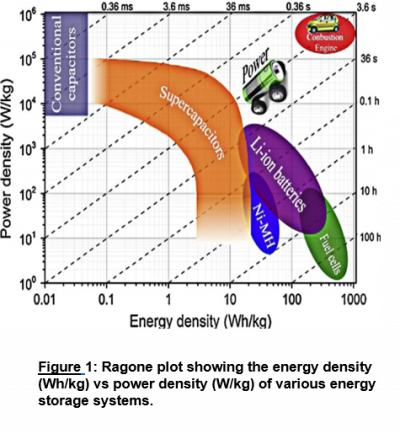Supercapacitors have generated widespread interest in the field of energy storage devices because of their unique ability to handle large influxes of energy. This means they can charge up in a matter of seconds, compared to the hours it takes for batteries, making them ideal for situations that require a quick response time and rapid rate of charge/discharge.

Supercapacitors have already been integrated in a number of commercial vehicles such as Toyota’s TS040 winner racing and Mazda’s i-Eloop energy recovery system. They are also used in public transport busses to provide a backup braking system and to guarantee that the bus doors can function even after an accident. Other practical applications of these devices are vast including many consumer electronics, memory back-up systems, military and medical applications and for use in robotics.
The appeal of the supercapacitor lies in its ability to fill a unique gap in the energy storage spectrum between the traditional functionalities of a battery and a capacitor. The Ragone plot in Figure 1 graphically depicts this by comparing the performance of various energy storage devices with regards to their energy (Wh/kg) and power (W/kg) densities.
Comparisons Between Batteries and Capacitors
Due to the shortcomings of both batteries and capacitors, supercapacitors have been employed to bridge the gap between the two energy storage systems in situations when fast power delivery is needed without severe compromises to the energy density. They are unique because they are able to maintain their ability to store charge in a reversible way and can operate with a high specific power that is substantially more than what is achievable with most batteries.
Batteries store potential energy in chemical form through charge-transfer reactions that occur at the electrode surface when a voltage is applied to a system. They have a large energy density allowing them to store substantial amounts of charge, however their rate of energy uptake, or power density, is extremely low, meaning they require hours to charge up. Additionally, side reactions that take place in batteries, limit the number of charge cycles the battery can endure. On the other hand, capacitors store their energy electrostatically in the form of potential energy in the electric field without the use of chemical reactions. This means they are able to undergo infinite charge cycles without degradation and that their charge uptake is not kinetically limited, allowing for a very high-power density. The major shortcoming with capacitors, however, is that their overall energy density is very low, resulting in an extremely limited amount of charge that can be stored per unit area in the device.
For comparison, the typical energy density for a capacitor, supercapacitor and a battery is around <0.1, 1-10 and ~20-150 Wh/kg, respectively, however their power density is >>10,000, 500-10,000 and <1000 W/kg. In addition, capacitors and supercapacitors are able to withstand more than 106 charge/discharge cycles as opposed to batteries that are only able to be cycled roughly 1500 times. This means the lifetime of capacitors and supercapacitors is greater than 10 years compared to ~3 years for batteries.
How They Work
Supercapacitors are constructed similarly to batteries in that they consist of two electrodes immersed in an electrolyte with an ion-permeable separator located between the electrodes to prevent electrical contact. They can be divided into two main groups: electrochemical double layer capacitors (EDLCs) and pseudo-capacitors. These two classes differ in their energy storage mechanisms as well as the type of active materials used in their electrodes. An additional third class of supercapacitors, the “hybrid capacitors”, has sparked recent interest as it incorporates various combinations of the other two systems.
Their ability to rapidly charge and discharge is a result of using high surface area materials such as porous carbons or metal oxides in their electrodes so that their charge storage mechanism is not dependent on slow chemical processes or phase changes to occur as is typically needed in batteries. In addition, the charge storage takes place on the surface of the active electrode material rather than in the bulk, meaning is it not subject to diffusion limitations that increase the time scale of charge uptake.
Supercapacitors, however, cannot be considered as replacements to batteries or other large energy storage devices like fuel cells as their mechanism for charge storage greatly differs and thus addresses separate, yet very necessary needs. This has made them a valuable addition to the portfolio of energy storage devices that are being studied but in no way means they are can operate on their own.
An optimal configuration would be to use a supercapacitor in conjunction with other energy storage devices in a hybrid system. This can lighten the load on the battery or fuel cell and help alleviate pressure at the kinetic limits where high stress promotes degradation. Studies have shown that the hybridization of batteries with supercapacitors have proved to offer level loading and therefore improve the batteries’ cycle lives and output voltages.
The supercapacitor’s ability to charge quickly, provide large pulse power, be transported safely and have no issues with waste disposal has swayed market trends in favor of their widespread adoption. With an upwards trajectory of many new applications becoming cost effective over the next few years, market growth of 3% yearly is anticipated making the advancement of this research very much worthwhile.
 Close
Close

